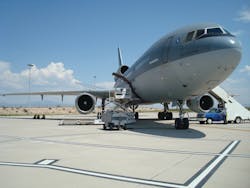Maintenance Tips For GPUs
When it’s time for your GPU to head to the shop for a PMI, there are a lot of areas to be inspected.
For example, if it’s been more than 300 hours since the GPU’s last inspection, an oil, oil filter, and fuel filter change is in order. The air filter should also be removed from the housing and checked. If it is very dirty, then it should be replaced.
- Other items should be inspected on the engine as well. Wiring, connections, and sensors should be checked for tightness and bare spots.
- If your unit uses an electronic actuator to operate the governor, all linkages should be checked for binding and lubricated as needed.
- Accessory belts should be checked for tightness and cracking.
- Intake hoses and exhaust piping should have all clamps checked for tightness. Batteries should be checked for proper electrolyte levels. The terminals and cables should be clean and tight.
- Engine mounts should be tight and the isolators should be free of cracking and distortion. The engine should be checked for any oil leaks as well.
COOLING SYSTEM
The GPU’s cooling system is very important due to the long hours that it will typically run. The coolant level, of course, should be kept full and should be a 50/50 antifreeze and water mixture. If the system uses an overflow tank, it should be kept at just below half-full.
- The radiator cap should be the correct pressure for the system and be free of cracks in the rubber seal. Radiator fins should be clean and straight.
- A thorough pressure wash will usually go a long way to help cooling efficiency. All cooling hoses should be checked for leakage and all clamps checked for tightness. If there is any green staining in the radiator fins, then there is a leak. A pressure test would be the next order of business.
CHASSIS
Next on the list should be an inspection of the GPU chassis and running gear.
- The brakes should be checked for proper operation and adjustment.
- Tires should be checked for proper inflation and wear. If the front tires are wearing unevenly. Then the alignment and toe settings should be checked.
- The tow bar requires attention, too. It should not have any excessive sideplay and the latch should lock the tow bar firmly in place.
- Wheel bearings need to be cleaned, inspected, and repacked every 2,000 hours or two years, whichever comes first.
GENERATOR
Now for the fun stuff – the generator system. If the output of the GPU is not set to exact specs, then the aircraft will not accept power.
Let’s take a look at the type of GPUs commonly used for commercial aircraft. These units put out 120V AC at 60Hz. The generator typically has at least a 90KVA rating for a single cable unit and a 120KVA or more rating for a dual cable machine. These units operate at 400Hz, which directly corresponds to engine and generator RPM.
All of these parameters are fully adjustable. By raising or lowering engine RPM, the frequency can be changed to be set to the proper level. Since the setting should be 400Hz plus or minus 5Hz, the aircraft typically will not accept power outside these parameters.
The voltage is adjustable as well. Anywhere from 110V AC to 120V AC is the target area. If the voltage is too high or low, the safety relay in the aircraft will open causing the GPU contactor to open. This in turn will interrupt power output. You may find that some aircraft operate more happily and without interruption at an exact voltage setting. We have found that newer aircraft are definitely more picky in this regard than older ones. A little experimentation may be in order to find a happy medium that your customer’s aircraft will work with.
A very handy tool to have during an inspection is a load bank. This machine will help fine-tune your unit to the proper specs and ensure your GPU can handle any load an aircraft requires.
A good working 90KVA GPU can hold at least a 180 amp load for 10 minutes or more. This test is also good for the GPU because it gets the exhaust very hot and burns out accumulated carbon and soot.
COMPONENTS
Once it is confirmed that the unit operates correctly, it is time to test and inspect the generator components.
The main cause for GPU power interruption is a worn-out cable plug. The plug should be checked for scrapes and abrasions due to being dragged on the ground. This will cause a loose plug connection.
The terminals inside should be checked for wear and roundness. The cable itself should be checked for cuts and abrasions.
If the contactor is not a sealed unit, remove the cover and check the contact surfaces. If any pitting is evident, it can be quickly repaired with fine sandpaper and contact cleaner.
And finally, all wiring should be checked and the generator should be clean and free of debris.
As usual, a bit of prevention now will save a lot of headache later when you have aircraft on the ground and equipment must operate to its full potential.
About the authors: Kenneth DeVolpi, manager of sales and marketing and special projects manager, has worked for Matheson for more than three years and has been in the aviation industry for more than 20 years, including 15 years with Northwest Airlines. Jason Chapman works in the company's GSE maintenance department and gained GSE mechanical experience with the U.S. Air Force and has worked in the commercial GSE industry for 12 years.
